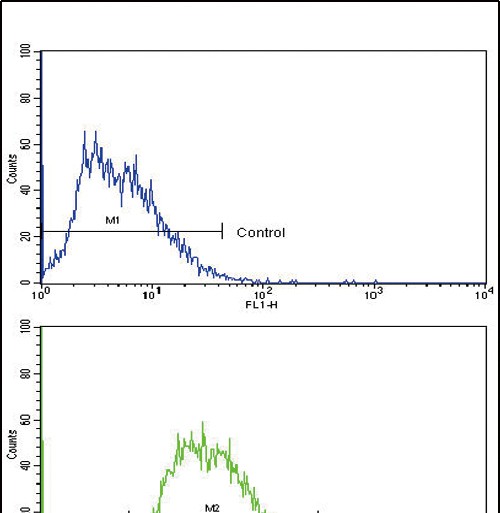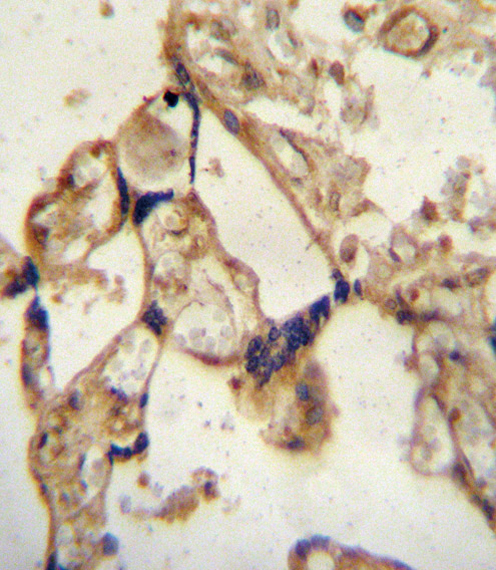


| WB | 咨询技术 | Human,Mouse,Rat |
| IF | 咨询技术 | Human,Mouse,Rat |
| IHC | 1/100-1/500 | Human,Mouse,Rat |
| ICC | 技术咨询 | Human,Mouse,Rat |
| FCM | 1/10-1/50 | Human,Mouse,Rat |
| Elisa | 咨询技术 | Human,Mouse,Rat |
| Aliases | ATP-binding cassette sub-family G member 2, Breast cancer resistance protein, CDw338, Mitoxantrone resistance-associated protein, Placenta-specific ATP-binding cassette transporter, Urate exporter, CD338, ABCG2, ABCP, BCRP, BCRP1, MXR |
| Entrez GeneID | 9429 |
| WB Predicted band size | 72.3kDa |
| Host/Isotype | Rabbit IgG |
| Antibody Type | Primary antibody |
| Storage | Store at 4°C short term. Aliquot and store at -20°C long term. Avoid freeze/thaw cycles. |
| Species Reactivity | Human, Mouse, Rat |
| Immunogen | This ABCG2 (BCRP) antibody is generated from rabbits immunized with a KLH conjugated synthetic peptide between 594-623 amino acids from the C-terminal region of human ABCG2 (BCRP). |
| Formulation | Purified antibody in PBS with 0.05% sodium azide,1%BSA and 50% glycerol.prepared by Saturated Ammonium Sulfate (SAS) . |
+ +
以下是关于ABCG2(BCRP)抗体的3篇参考文献示例,包含文献名称、作者及摘要概括:
---
1. **文献名称**:*The ABC transporter Bcrp1/ABCG2 is expressed in a wide variety of stem cells and is a molecular determinant of the side-population phenotype*
**作者**:Zhou S, et al.
**摘要**:该研究利用抗ABCG2抗体(BXP-53)通过流式细胞术鉴定小鼠和人类干细胞中的“侧群”表型,证实ABCG2是维持干细胞特性的关键转运蛋白,并验证了抗体在识别干细胞群体中的特异性。
---
2. **文献名称**:*Characterization of monoclonal antibodies recognizing human ABCG2 (BCRP)*
**作者**:Nakanishi T, et al.
**摘要**:研究通过免疫印迹和免疫组化验证了多种抗ABCG2单克隆抗体(如5D3、BXP-21)的特异性,发现不同表位抗体在肿瘤细胞膜定位及耐药性检测中的差异,为抗体选择提供实验依据。
---
3. **文献名称**:*Breast cancer resistance protein (BCRP/ABCG2) localizes to the nucleus in glioblastoma multiforme cells*
**作者**:Bhatia A, et al.
**摘要**:使用抗ABCG2抗体(BXP-34)进行免疫荧光和细胞分馏实验,发现ABCG2在胶质母细胞瘤细胞核中异常表达,提示其可能参与DNA修复或核内药物外排的新机制。
---
**备注**:上述文献可通过PubMed或Google Scholar搜索标题获取全文。如需更近期研究,可关注近年《Journal of Histochemistry & Cytochemistry》或《Molecular Cancer Therapeutics》相关论文。
ABCG2 (ATP-binding cassette subfamily G member 2), also known as BCRP (Breast Cancer Resistance Protein), is a transmembrane protein belonging to the ATP-binding cassette (ABC) transporter superfamily. It functions as an efflux pump, utilizing ATP hydrolysis to transport a wide range of endogenous and exogenous substrates, including chemotherapeutic agents, toxins, and metabolic byproducts. Structurally, ABCG2 exists as a half-transporter with six transmembrane domains and one nucleotide-binding domain, requiring dimerization for functional activity.
Primarily expressed in tissues with barrier or excretory functions (e.g., placenta, blood-brain barrier, liver, intestine), ABCG2 plays critical roles in xenobiotic protection, drug absorption, and tissue detoxification. Its overexpression in cancer cells is linked to multidrug resistance (MDR), limiting therapeutic efficacy by ejecting anticancer drugs. Additionally, ABCG2 is a key marker in stem cell populations, where it regulates the export of porphyrins and maintains cellular homeostasis.
Antibodies targeting ABCG2 are essential tools for studying its expression, localization, and function. They are widely used in Western blotting, immunohistochemistry (IHC), and flow cytometry to investigate its role in drug resistance, stem cell biology, and disease pathogenesis. Specific clones (e.g., 5D3. BXP-21) recognize distinct epitopes, enabling applications across experimental models. Research on ABCG2 antibodies also supports drug development, pharmacokinetic studies, and personalized medicine by identifying genetic variants (e.g., Q141K polymorphism) affecting transporter activity and patient responses to therapeutics.
×